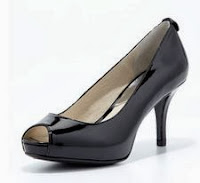
.Shoes 101
As many of you know I love shoes and it took me years to understand what all of the different styles of shoes are and which ones flattered you the most. I will start with the basics to help explain two dozen of the most common shoe styles.
Pointy toe
This is my favorite style of shoe! This shoe has an exaggerated pointed toe which elongates your leg. It makes you look longer and leaner. They are one of the most flattering types of shoes & are very comfortable. Every woman should one a pair. You can get them in either flats or heels.
Round toe
This shoe has a rounded toe which is like the ballet flat. It is very trendy right now with the use of color blocking on the toe. It is a very classy timeless look.
Pumps
The classic covered toe shoe with a think heeled base and can have a low, medium or high heel. I do love my pumps and tend to own mostly this style with a pointy toe and a kitten heel which I can run around the office in all day.
Kitten heel
This shoe can be either a pump or slide and has a short heel. The typical heel height is 1"-2" tall. They are very comfortable and give a girl a little extra height which we all love.
Slingbacks
This shoe can be either a flat or pump and have a strap that runs behind the ankle which helps to keep the shoe secure to your foot.
Stilettos
The stiletto heel has a thin high heel that are usually 3.5" tall or higher. They are very sexy and they make you strut when you wear a pair. I had to show the famous blue stilettos from Sex and the City since that show has made me a show lover.
Ballet flat
A flat shoe with either no heel or a very minim heel which is reminiscent of a ballet slipper. It has a rounded toe and a little bow tied on the front. These are great with skinny jeans or a busy day at the office when you know you will be on your feet all day. Try a fun color or pattern to mix things up instead of the classic black.
Flats
A shoe that has no heel or a very slight heel is a flat. Most shoe styles now come in flats and they are a big trend for 2014.
Loafer
A slip on shoe inspired by menswear. They are very trendy right now and have fun with color and extra metal accessories on them to give a little feminine touch. I just bought myself a pair since I just had toe surgery and I need a wider toe box shoe to wear for a while.
Oxfords
This shoe laces up and is also inspired by menswear. It can be a low or high heel and has leather details such as punched out designs along the sides and top of the shoe.
This high heeled shoe has added height by an extra thick front of the sole. This design allows women to comfortably wear 4" + high shoes.
Wedge
This shoe has a triangular shaped heel that gives height while providing stability. I love wedges and I can wearing taller wedge shoes since they are more stable. They come as a sandal or a pump or many other styles.
D'Orsays
This shoe cuts away at the sides to create two sections. A toe and a heel section. I find them very sexy and I love this shoe since it was used in my favorite Sex and the City episode. "A woman's right to shoes".
Peep toe
This shoe can be either a flat or a high heel. It has a small opening at the front of the toe that allows a few toes to peep out.
T-Strap
This shoe has a strap on that comes up the top center of the foot and attaches to a strap that goes around the ankle. It can be either a flat or a heel.
Sandal
This shoe can be either very high or low and features straps and does not cover the toes.
Strappy sandal
This sandal typically has a stiletto heel and has multiple straps that crisscross in various patterns across the toes and ankle.
Slides
Open toe shoe with a high or low heel. This shoe is backless. This is similar to the mule shoe but the mule has a closed toe.
Ankle boot
This boot has a low or high heel and they cut off just below, right at, or slightly above the top of the ankle bone. They are great under pants or jeans. I live in my ankle boots all winter when I wear pants.
Flat boot
This boot comes to the knee or mid calf and have an equestrian style or a motorcycle shape. They have a flat heel or have a very low stacked heel.
Tall boot
A knee high (or taller) boot which every women needs a pair. They can be very slim and sexy or chunky and edgy. They fit everyone's personal style. I love wearing mine with skirts all winter. I own a black, grey, brown, and tan pair. Love these!!!
Thong
This shoe is distinguished by a strap that runs up between the big and second toe. A favorite to wear in the summer
Espadrilles
This shoe features a wedge heel made out of rope traditionally. They are very comfortable and can be open or closed toe.
Gladiator
These flat sandals are inspired by the ones worn by the Roman fighters. They have many straps across the ankle and across the foot. They also are down as high heels or tall boots.
Be adventures with your shoes and try as many styles you can since it is an easy way to express yourself.
















































